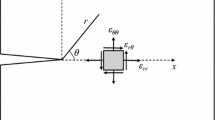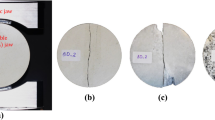Abstract
In order to investigate the influence of water vapor pressure in the surrounding environment on mode I fracture toughness (K Ic) of rocks, semi-circular bend (SCB) tests under various water vapor pressures were conducted. Water vapor is one of the most effective agents which promote stress corrosion of rocks. The range of water vapor pressure used was 10−2 to 103 Pa, and two anisotropic rock types, African granodiorite and Korean granite, were used in this work. The measurement of elastic wave velocity and observation of thin sections of these rocks were performed to investigate the microstructures of the rocks. It was found that the distribution of inherent microcracks and grains have a preferred orientation. Two types of specimens in different orientations, namely Type-1 and Type-3, were prepared based on the anisotropy identified by the differences in the elastic wave velocity. K Ic of both rock types was dependent on the water vapor pressure in the surrounding environment and decreased with increasing water vapor pressure. It was found that the degree of the dependence is influenced by the orientation and density of inherent microcracks. The experimental results also showed that K Ic depended on the material anisotropy. A fracture process was discussed on the basis of the geometry of fractures within fractured specimens visualized by the X-ray computed tomography (CT) method. It was concluded that the dominant factor causing the anisotropy of K Ic is the distribution of grains rather than inherent microcracks in these rocks.
















Similar content being viewed by others
References
Al-Shayea NA (2002) Comparing reservoir and outcrop specimens for mixed mode I–II fracture toughness of a limestone rock formation at various conditions. Rock Mech Rock Eng 35(4):271–291
Al-Shayea NA, Khan K, Abduljauwad SN (2000) Effects of confining pressure and temperature on mixed-mode (I–II) fracture toughness of a limestone rock. Int J Rock Mech Min Sci 37:629–643
ASTM International (2010) ASTM E112-10. Standard test methods for determining average grain size. ASTM, Philadelphia
Atkinson BK, Meredith PG (1987) The theory of subcritical crack growth with applications to minerals and rocks. In: Atkinson BK (ed) Fracture mechanics of rock. Academic Press, San Diego, pp 111–166
Atkinson C, Smelser RE, Sanchez J (1982) Combined mode fracture via the cracked Brazilian disk test. Int J Fract 18(4):279–291
Barker LM (1977) A simplified method for measuring plane strain fracture toughness. Eng Fract Mech 9:361–369
Chong KP, Kuruppu MD (1984) New specimen for fracture toughness determination for rock and other materials. Int J Fract 26:R59–R62
Fowell RJ, Chen JF (1990) The third chevron-notched rock fracture specimen—the cracked chevron-notched Brazilian disc. In: Proceedings of the 31st US Rock Mechanics Symposium, Golden, Colorado, June 1990. Balkema, Rotterdam, pp 295–302
Freiman SW (1984) Effects of chemical environments on slow crack growth in glasses and ceramics. J Geophys Res 89:4072–4076
Funatsu T, Seto M, Shimada H, Matsui K, Kuruppu M (2004) Combined effects of increasing temperature and confining pressure on the fracture toughness of clay bearing rocks. Int J Rock Mech Min Sci 41(6):927–938
ISRM Testing Commission (1988) Suggested methods for determining the fracture toughness of rock. Int J Rock Mech Min Sci Geomech Abstr 25:71–96
ISRM Testing Commission (1995) Suggested method for determining mode I fracture toughness using cracked chevron notched Brazilian disc (CCNBD) specimens. Int J Rock Mech Min Sci Geomech Abstr 32:57–64
Jeong HS, Kang SS, Obara Y (2007) Influence of surrounding environments and strain rates on strength of rocks under uniaxial compression. Int J Rock Mech Min Sci 44:321–331
Karfakis MG (1986) A critical review of fracture mechanics as applied to hydraulic fracturing stress measurements. In: Proceedings of the 1986 SEM Spring Conference on Experimental Mechanics, New Orleans, June 1986, pp 141–147
Kataoka M, Obara Y (2013) Estimation of fracture toughness of different kinds of rocks under water vapor pressure by SCB test. J MMIJ 129:425–432 (in Japanese)
Kataoka M, Obara Y, Kuruppu M (2011) Estimation of fracture toughness of anisotropic rocks by SCB test and visualization of fracture by means of X-ray CT. In: Proceedings of the 12th ISRM International Congress, Beijing, China, October 2011, pp 667–670
Kataoka M, Hashimoto A, Sato A, Obara Y (2012) Fracture toughness of anisotropic rocks by semi-circular bend (SCB) test under water vapor pressure. In: Proceedings of the 7th ARMS, Seoul, Korea, October 2012, pp 458–465
Kataoka M, Obara Y, Jeong HS (2013) Influence of water vapor pressure in surrounding environment on strength and fracture toughness of rocks. In: Proceedings of the ISRM International Symposium EUROCK 2013, Wrocław, Poland, September 2013, pp 21–26
Kataoka M, Ito T, Takashima K, Obara Y (2014) A new testing method to estimate microscopic fracture toughness of rock. In: Proceedings of the ROCKMEC XIth Regional Rock Mechanical Symposium, Afyonkarahisar, Turkey, May 2014, pp 91–96
Kudo Y, Hashimoto K, Sano O, Nakagawa K (1986) The empirical knowledge of quarryman and physical properties of granite. JSSMFE 34:47–51 (in Japanese)
Kudo Y, Sano O, Murashige N, Mizuta Y, Nakagawa K (1992) Stress-induced crack path in Aji granite under tensile stress. Pure Appl Geophys 138:641–656
Kuruppu MD, Obara Y, Ayatollahi MR, Chong KP, Funatsu T (2014) ISRM-suggested method for determining the mode I static fracture toughness using semi-circular bend specimen. Rock Mech Rock Eng 47:267–274
Lee SE, Cho SH, Seo YS, Yang HS, Park HM (2001) The effect of microcracks on the mechanical anisotropy of granite. Mater Sci Res Int 7:7–13
Meredith PG, Atkinson BK (1985) Fracture toughness and subcritical crack growth during high-temperature tensile deformation of Westerly granite and Black gabbro. Phys Earth Planet Int 39:33–51
Mukunoki T (2013) Proceedings of the 4th International Workshop on X-ray CT Visualization for Socio-Cultural Engineering and Environmental Materials X-Earth
Nasseri MHB, Mohanty B (2008) Fracture toughness anisotropy in granitic rocks. Int J Rock Mech Min Sci 45:167–193
Obara Y, Sasaki K, Matsuyama T, Yoshinaga T (2006) Influence of water vapor pressure of surrounding environment on fracture toughness of rocks. In: Proceedings of the 4th ARMS, Singapore, November 2006, chapter 7
Obara Y, Sasaki K, Yoshinaga T, Suzuki Y (2007) Influence of water vapor pressure of surrounding environment on fracture toughness and crack velocity of rocks. In: Proceedings of the 11th ISRM International Congress, Lisbon, Portugal, July 2007, pp 51–54
Ouchterlony F (1980) A new core specimen for the fracture toughness testing of rock. Swedish Detonic Research Foundation Rep DS, Stockholm
Ouchterlony F (1981) Extension of the compliance and stress intensity formulas for the single edge crack round bar in bending. ASTM STP 745:237–256
Schedl A, Kronenberg AK, Tullis J (1986) Deformation microstructures of Barre granite: an optical, SEM and TEM study. Techtonophysics 122:149–164
Tutluoglu L, Keles C (2011) Mode I fracture toughness determination with straight notched disk bending method. Int J Rock Mech Min Sci 48:1248–1261
Whittaker BN, Shingh RN, Sun G (1992) Rock fracture mechanics: principles, design, and applications. Developments in geotechnical engineering. Elsevier, Amsterdam
Author information
Authors and Affiliations
Corresponding author
Rights and permissions
About this article
Cite this article
Kataoka, M., Obara, Y. & Kuruppu, M. Estimation of Fracture Toughness of Anisotropic Rocks by Semi-Circular Bend (SCB) Tests Under Water Vapor Pressure. Rock Mech Rock Eng 48, 1353–1367 (2015). https://doi.org/10.1007/s00603-014-0665-y
Received:
Accepted:
Published:
Issue Date:
DOI: https://doi.org/10.1007/s00603-014-0665-y




